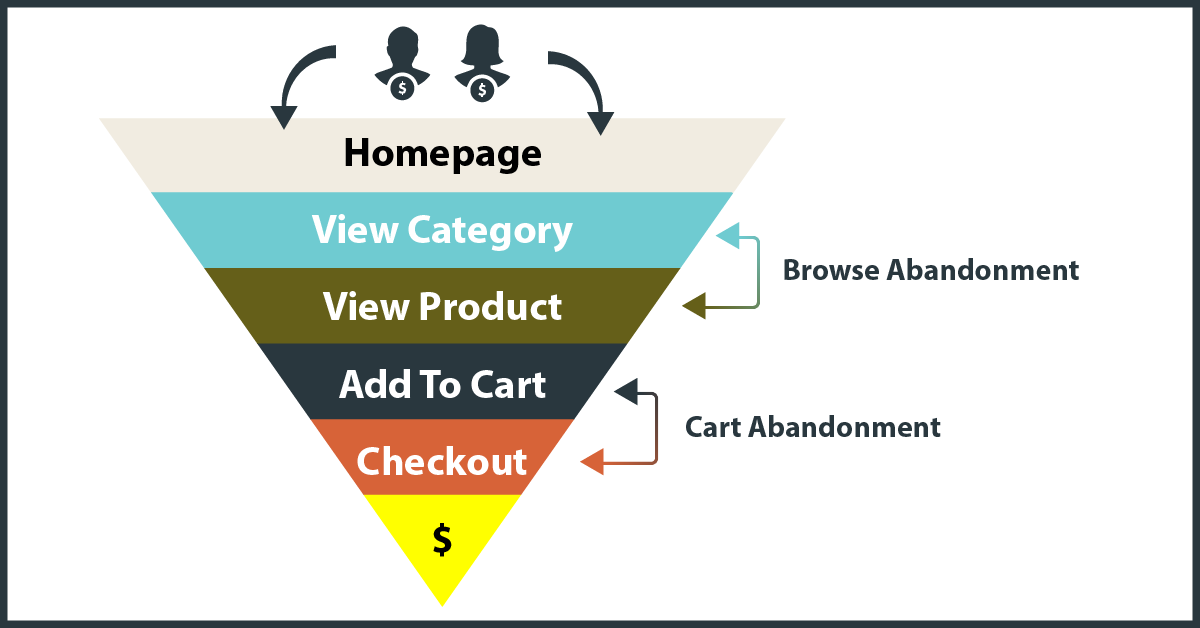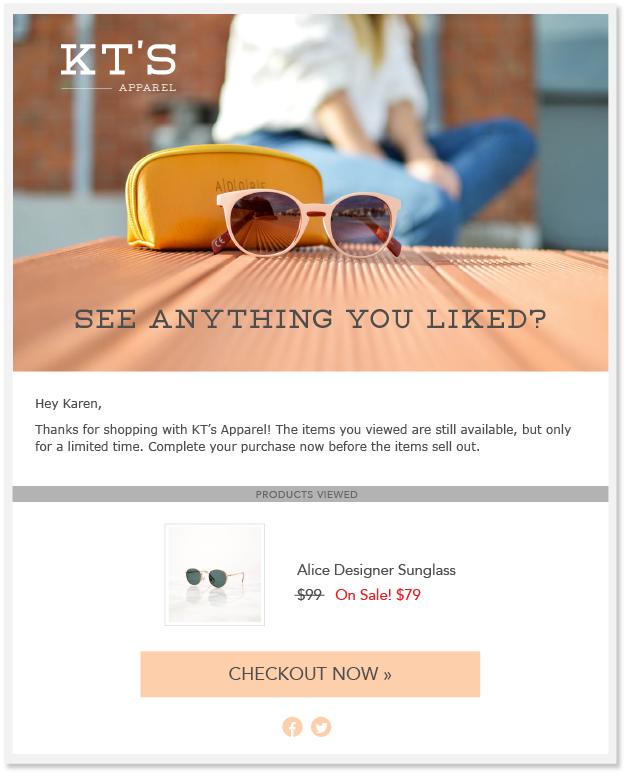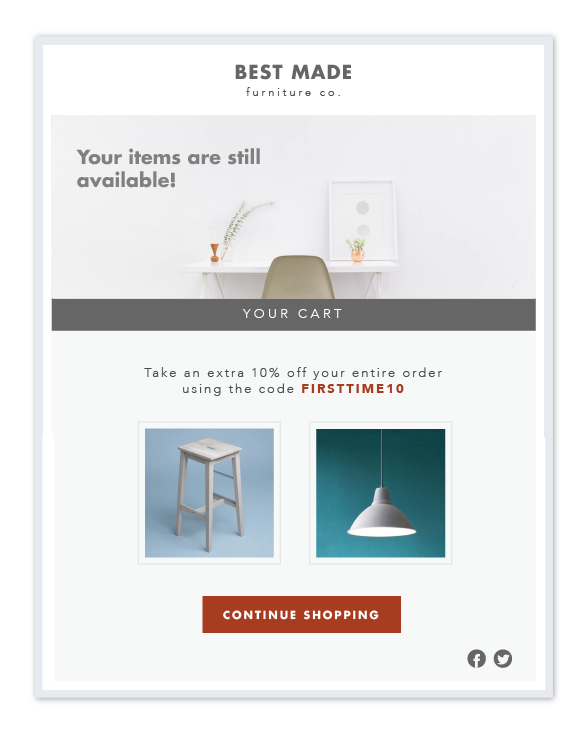Browse Abandonment Email Best Practices & Subject Lines
December 6, 2019
Recent research shows that 58.6% of US shoppers have abandoned an online shopping cart in the past three months because they were “just browsing.” That’s one in every two people visiting your website without even adding a product to their basket. But what is this common occurrence, and how can you stop it?
Browse abandonment is the process of someone abandoning your website before adding a product to their shopping cart. You may have also heard it referred to as discovery failure, window shopping, or simply “just looking.” Either way, it’s frustrating and negates your marketing ROI, while depleting your profits.
Browse abandonment is also very distinct from cart abandonment. Cart abandonment occurs when a shopper has added an item to their shopping cart, while browse abandonment occurs earlier in the customer journey. This earlier stage makes browse abandoners more challenging to re-engage and convert because:
- They are less engaged with your brand because they’ve spent less time on your website.
- They have no emotional connection with your products because they haven’t added an item to their basket.
- In the words of U2, they still haven’t found what they were looking for.

However, they came to your website for a reason, meaning that there’s a glimmer of hope that can be saved. By using browse abandonment best practices and subject lines you can recover visitors, boost engagement and increase conversion rates. And this week, we’re taking a deeper look.
Browse abandonment best practices
With the right tools, techniques, and best practices, we’ve seen browse abandonment campaigns convert anywhere between 3-7% of window shoppers into customers. With browse abandonment rates so high, that’s a significant amount of lost revenue to recover. So, where do you begin?
1. Create a browse abandonment strategy
Let’s get one thing straight first. Browse abandonment isn’t the same as cart abandonment. As already mentioned, visitors leaving your website before adding an item to their basket are further behind in the customer journey. Accordingly, your cart abandonment campaign isn’t relevant, making your cart abandonment emails useless.
For example, emails with a subject line such as “Don’t leave a good thing behind” or “We’ve saved your cart for you” aren’t applicable and are therefore unlikely to be opened. Email content that relies heavily on scarcity or urgency can feel too intense and pressurized for visitors who aren’t yet familiar with your brand.
Instead, your browse abandonment strategy should have two goals: 1) to gently re-engage customer interest and 2) if you can, to softly recover their lost purchase.
2. Capture email addresses as soon as possible
Browse abandonment visitors leave your website before adding to their shopping cart, which means that they haven’t yet created a customer account or entered details into your checkout page. To target these customers, you must capture their email address much earlier than you do for cart abandonment.
To accomplish this, you’ll want to use a recovery tool that 1) Tracks and records your visitor’s behavioral and contact data in real time while they navigate your site and 2) is cookie-based, rather than account-based.
Intelligent real-time visitor tracking tools record a customer’s visit to your website, capturing contact and personal information entered into any text fields. This information is then automatically used to queue visitors into the appropriate recovery campaign, depending on when they left your site.
However, using a cookie/pixel-based solution is really the magic sauce, when it comes to a browse abandonment email campaign. Why? Because your cart abandonment campaigns will not work on every abandoned cart lead. Yet many of your abandon cart shoppers will return to your website to shop again in the future. And if they’re still cookied & identified from their previous visit, it doesn’t matter if they enter an email address anywhere, because you still have it from their previous visit!
Regardless, it is still important to identify innovative ways to encourage email address input. Some methods that CartStack customers use include:
Contact page
Add a contact form to your contact page for visitors who have questions about your website and products. This removes the requirement of them emailing or calling you, and it gathers their email address to use in your browse abandonment campaign.
Live chat
Use a live chat plugin that requires an email address to commence the conversation. The live chat functionality enables you to answer queries to prevent browse abandonment from happening, and the email address can be used if the customer fails to convert or your agent is unavailable at the time.
Popups and offers
Run delayed popups that appear after a set amount of time or exit intent popups that appear as a visitor attempts to leave. Use this disruption to ask customers for their contact details in exchange for something of value, such as a newsletter signup, discount, or loyalty program.

Send my Cart
Implement Send my Cart functionality on your website that allows customers to create a shopping cart and email it to themselves. This is convenient for visitors who aren’t yet ready to purchase but are interested in saving their progress, and it provides you with essential contact information.

3. Send the right message at the right time
Visitors leaving your website early in the customer journey have a much lower purchase intent than that of someone abandoning their shopping cart. Accordingly, their interest in your brand cools much quicker than that of a cart abandoner – meaning that you need to quickly strike with the right message while their interest is still hot.
While a successful cart abandonment drip email campaign might take place over a week, browse abandonment campaigns typically aren’t very effective when sent more than three days after abandonment. At CartStack, we recommend the following pattern:
- Email #1 sent within 20 minutes of abandonment.
- Email #2 sent the day after abandonment.
- Email #3 sent two or, at most, three days after abandonment.
In addition to timing, it’s necessary to adopt the right tone in each email. As mentioned, these customers are less engaged with your brand and products. Therefore, adopting an overly familiar tone or persuasive nature can come across as too salesy or, if they don’t remember your website, as spam.
Instead, offer help and support by using a friendly tone and neutral tone to introduce your brand, re-engage their interest, and invite them back to your store. We recommend the following:
- Email #1 – a supportive and helpful tone.
- Email #2 – a gentle but persuasive tone.
- Email #3 – a slightly more familiar tone.
4. Capture attention with a subject line
Closely related to sending the right message at the right time is your browse abandonment email subject line. 47% of people open an email based on the subject line alone – so if you’re referring to the customer’s shopping basket, a product they’re about to miss out on, or anything else related to cart abandonment, your email is unlikely to be opened. Likewise, if your subject line is dull, unclear, or just like every other subject line out there, it’s likely to fall within the 53% of subject lines that aren’t opened.
We’re going to cover the top browse abandonment subject lines that get opened below. In the meantime, just remember that your subject line needs to be relevant, while attention-grabbing.
5. Engage with personalized content
We’ve mentioned it before, and we’re going to mention it again (it’s really important) – browse abandonment visitors are less engaged with your brand. In fact, some of these visitors won’t even recall your website name. Therefore, sending an overly personalized email with all of the products they looked at and pages they visited can come across as a little creepy – especially if you’re using retargeted ads at the same time.
However, there’s no doubt about it – personalization is an effective engagement tool. Accordingly, you want to adopt a slightly toned-down approach. This can be achieved by the following:
- Including one product that they were looking at, alongside other relevant information that diverts attention away from the personalization. For example, including social proof, enhanced product information, or product comparisons.
- Using an AI-driven product recommendation engine to recommend products based on the items they were looking at.
- Sending discounts and deals that relate to the items or categories they spent the most time browsing. For example, 20% off surfing equipment.

Remember, unlike cart abandonment email campaigns where your goal is for a customer to complete their purchase, browse abandonment campaigns aim for the customer to start their purchase. If your products didn’t appeal enough to be added to the customer’s basket the first time, focusing your whole email on those same products the second time is unlikely to yield a different result.
6. Overcome purchase barriers
There’s always a reason why someone left your website before clicking add to cart. It could be something as simple as Netflix, dinner, or both. It could be something technical such as speed, broken links, or unclear navigation. Or, it could be something deeper such as a lack of trust, unclear pricing, or slow shipping speeds.
Whatever the purchase barrier causing abandonment, it’s important to know what it is. You can do this by using abandoned session replays to pinpoint the moment a customer leaves your website and narrow down the possible causes. For example, if customers are leaving after visiting your delivery information page, your shipping costs or speeds are likely the problem.
Once you have identified the common purchase barriers, you can overcome them using appropriate tactics in your browse abandonment email campaign. For example:
- If customers are leaving after visiting your delivery information page, send a free shipping discount code in your recovery email.
- If customers are leaving after reading your returns policy, send an email that includes customer testimonials about your products and social proof about your brand.
- If customers are leaving after spending an extended amount of time on a particular product page, send an email offering a discount.

7. Split test the results
Browse abandonment recovery is a little like cooking – you need to tweak and test the ingredients until you get the right results. By using A/B split testing to trial different email campaigns and approaches, you can identify the methods that work for your customers and the ones that don’t.
Browse abandonment subject lines
Don’t worry, we didn’t forget. The key to your browse abandonment email campaign working is your emails being opened in the first place. A typical email marketing campaign can expect to achieve a 15% open rate. However, these CartStack-approved browse abandonment subject lines achieve rates as high as 40-60%, and it’s all about sending the right message at the right time.
Browse abandonment subject line #1 – supportive and introductory
- Thank you for visiting – do you need any help?
- Did you see something you liked?
- We didn’t get a chance to say hello…
Browse abandonment subject line #2 – incentivizing
- [Name] – we think you might like these products
- [Inside] $5 off your first order
- Welcome aboard and say hello to 20% off
Browse abandonment subject line #3 – keeping the door open
- We noticed you checking us out
- Recommended just for you
- Would you like to keep hearing from us?
And, if these emails don’t result in a conversion, you can use Zapier to transfer your leads into your CRM platform and future mass-marketing campaigns.
Browse abandonment best practices tl;dr
While online retailers are focused on solving cart abandonment, many are overlooking the growing problem of browse abandonment. However, by adopting the above best practices and remembering to “send the right message at the right time,” you can recover significantly more customers while using many of the same tools as your cart abandonment campaign.
CartStack’s suite of browse abandonment tools enables you to identify, queue, and target shoppers who were only browsing your website, powering you to put the above methods into practice. To find out more, sign up for a free trial today.





